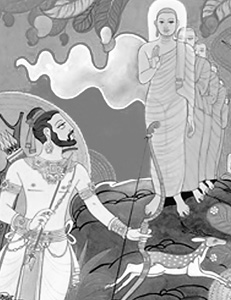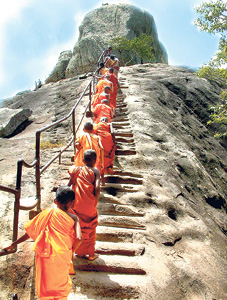June is the month of Poson – a most significant month for Sri Lanka,
particularly for Sri Lankan Buddhists. Poson marks the introduction of Buddhism to Sri Lanka which in effect meant the beginning of a great
civilization over many
centuries.
With Arahat Mahinda, the son of King Asoka of India, arriving at Mihintale, eight miles to the east of the country's capital Anuradhapura,
pilgrims flock to the sacred mountain to commemorate the event.
"There the Elder arose like the king of swans in the sky and established himself on the cloud-like mountain, to the east of the best of towns, on top of the Missaka mountain, like swans on the summit of a mountain." This is how Dipavamsa, the Island Chronicle written in the 4th century A.D., describes the arrival of Arahat Mahinda on the hilltop.
Under the shadow of 'araliya' trees, pilgrims traverse the main flight of stone steps at the foot of the mountain to reach Ambastala, where several places of worship have been established.
It is an easy trudge with the steps being situated at very convenient levels. The 1,840 steps have been arranged in three flights, the pilgrims being able to rest at every level, if they wish to. They can even divert from each flight to view ruins dating back to the days of the Anuradhapura kings.
At the highest plateau at the end of the flight of steps is the Ambastala Dagaba or Sela Chetiya, which is believed to have been built on the site
hallowed by the Buddha
himself.
(Sela Chetiya is mentioned as one of the 16 places
sanctified by the Buddha during his visits to Sri Lanka).
It is surrounded by concentric circles of stone pillars. After resting for a while, the
pilgrim would worship these sites and then make his or her way to several significant places related to the visit of Arahat Mahinda.
On the left on the hillock is the Maha Stupa, the largest of the
stupas at Mihintale. Going down a footpath on the left, one
reaches the 'Mihindu Guhawa,' the cave where Arahat Mahinda spent most of his time. It is a
picturesque
setting with the view of the
surrounding mountains through the cave most arresting. The rock bed used by the sage can still be seen.
The pilgrims queue up to reach the 'aradhana gala' – the top of the rock where Arahat Mahinda and his five disciples appeared. The chronicles describe the dialogue between Arahat Mahinda and King Devanampiyatissa (247 – 207 BC), the ruler of Anuradhapura who was on a hunting expedition at the time Arahat Mahinda arrived. The dialogue was to test the king's ability to grasp the doctrine and being satisfied with the intelligence he displayed, Arahat Mahinda preached a sermon after which the king and his retinue became Buddhists.
Kantaka Chetiya is one of the most popular sites at Mihintale because of the elaborately
sculptured 'vahalkadas' or frontispieces. The 'vahalkada' is considered the most important
architectural feature of a 'stupa.' Four of them are seen at the four cardinal points – east, west, north and south. The 'vahalkada' is supposed to have evolved from the flower dais where the devotees offer flowers to the 'stupa.'
There is also evidence of a developed hydraulic civilization at Mihintale. 'Kaludiya Pokuna' (Pond of black water) is the largest of the ponds at Mihintale.
A large amount of ruins are found at Mihintale including residences of monks, assembly halls and the like. This proves that a large community of monks had lived there having donned the robe. |


